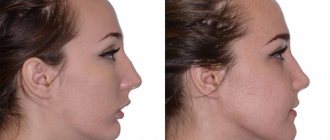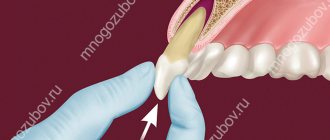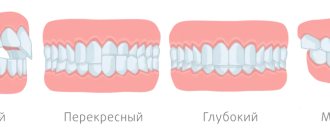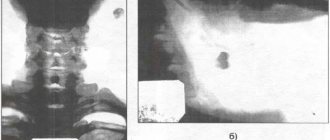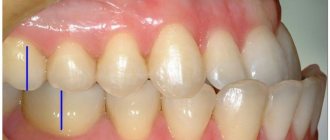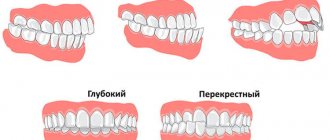And this has been proven by research by American psychologists!
The angles of the lower jaw can be simply smoothed, not expressive, and this makes the face softer. For men, this can result in a lack of masculinity and decisiveness in appearance; for women, this can result in a lack of some “vampirism” and coquetry. It is believed that a pronounced lower jaw is a sign of “breed”, which can affect society’s perception of a person.
Aesthetic studies have shown that the average mandibular angle in women is 125 degrees , but this value varies even among aesthetically attractive patients.
The main goal when correcting the lower part of the face is to emphasize and make the patient’s natural mandibular angle more pronounced.
You should not strive for the geometric number of a specific angle! Simply accentuate the corners!
Correction of the lower jaw is often carried out in combination with changes to the chin , and sometimes it is carried out not as a single manipulation, but as a component of a complex for correcting the entire oval of the face, for example in the “Jolie profile” procedure.
Photos before and after complex correction
Here and below, the before and after photos were taken by cosmetologists of our clinic using cannula technology.
Unlike the middle third of the face, where soft boundaries are aesthetically ideal, the transition from the jaw line to the neck is characterized by clearer angles and lines, which are important to recreate during correction. Therefore, to correct this area, dense preparations with good elasticity are desirable.
After the age of 35-40, special attention should be paid to the correction of the upper and middle third of the face (zygomatic area and facial wrinkles of the forehead).
Sometimes, at the angles of the lower jaw, some patients trim the shape of the chin in front and profile. This is not a mistake, but rather a comprehensive approach to correcting this zone.
Types of malocclusion
There are several types of malocclusion. Based on this, the method of treatment is selected. Types of malocclusion:
- Distal. Visually noticeable protrusion of the upper jaw over the lower jaw. In this case, the incisors do not contact each other well or do not contact at all.
- Open. The most complex type of malocclusion. The dental arches do not touch each other. This leads to speech impediments and constant tension in the facial muscles.
- Mesial. The lower jaw is strongly pushed forward. Visually identified by a sunken upper lip.
- Deep. The upper incisors overlap half the lower teeth. As a result, injury to the oral mucosa occurs. This leads to problems with eating and rapid wear of the enamel of the front incisors.
- Cross. Incorrect development of the upper and lower rows of teeth. The incisors can intersect with each other in the lateral or front part of the jaw. The patient has speech impairment, problems eating, and difficulty breathing.
Indications and contraindications
Surgery to correct malocclusion is indicated for patients who have complaints of:
- swallowing disorder;
- problems with biting and chewing food;
- violation of diction;
- lip failure;
- protrusion and retraction of the lower jaw.
Facial plastic surgery is performed by an oral and maxillofacial surgeon for patients with any type of malocclusion:
- Distal bite. Patients are characterized by the following features: a lower jaw of normal or reduced size combined with an abnormal position of the upper jaw. With a distal bite, the patient's lips do not close and he experiences difficulty chewing food. Pathology significantly distorts the appearance of the face. Surgical method is the main method of treating malocclusion. The age of the patient is a contraindication: surgical intervention is not recommended before the age of 18, since the natural processes of growth and development of the skull bones can distort the result obtained or provoke a recurrence of the anomaly.
- Mesial bite. This diagnosis is characterized by protrusion of the lower jaw forward. In addition to the external defect, people with mesial occlusion have problems with diction and normal food intake. For mesial occlusion, surgical treatment is indicated.
- Deep bite. With such an anomaly, the teeth of the upper row cover the lower ones by more than a third of the height. A deep bite has an extremely negative effect on the health of teeth: uneven distribution of the load provokes abrasion, destruction and various diseases.
- Narrowing of the upper jaw. Underdevelopment of the upper jaw causes pain in the joints, and also severely crooks the dentition due to the lack of space necessary for the outer teeth. A narrowing of the upper jaw can be corrected without surgery if the patient is under 18 years of age. The orthodontist installs a special spacer on the upper jaw to eliminate the defect. For older people, surgical correction of the bite is indicated.
- Crossbite. Often, patients with the anomaly have distorted facial proportions. Asymmetry is caused by improper closure of the dentition: on one or two sides, the teeth of the lower dentition overlap the upper ones. The defect is congenital and is associated with anomalies in the proportion between the jaws: the upper is narrower than the lower.
Contraindications for the procedure are:
- blood pathologies associated with coagulation disorders;
- infections;
- inflammatory processes in the body;
- diabetes;
- nervous system disorders.
The decision to undergo jaw surgery is a serious step that requires lengthy preparation, significant financial costs and a difficult recovery period. It is important to conduct a detailed examination and consult with an orthodontist and surgeon before agreeing to surgery. If, after evaluating and comparing all the pros and cons, a decision is made to correct the bite surgically, the patient can rest assured that he will forever say goodbye to the problems of dental anomalies and return to a full-fledged lifestyle.
Indications for surgery
Correcting the bite is a complex operation aimed at creating the correct proportions of the face and preventing the development of various diseases of the oral cavity. The feasibility of the intervention is determined by the doctor after diagnosis. The operation is indicated in the following cases:
- Asymmetrical or disproportionate face.
- Violation in the relationship between the patient's upper and lower jaw.
- Inability to close lips completely.
- Problems with pronunciation or swallowing.
Ideal proportions of the lower third of the face
The lower jaw consists of a horseshoe-shaped body and ascending branches, which are directed towards the temples and are located at an angle to the body of the jaw. If this angle exceeds 125°, the lower third of the face has an oval or triangular shape; with a less flat angle, the jaw looks square or round. The angle of the lower jaw is not only an anatomical, but also an age-related feature: in young children it is 150-160°, and the figure decreases with age.
The ideal proportions of the lower part of the face were calculated back in the Renaissance: a horizontal line is drawn from the middle of the interval between the lips and chin; when it intersects with the ascending branch of the lower jaw, it should form an angle of 100-110°. Such proportions create a “v-line”, that is, when viewed from the front, the line of the lower jaw resembles the Latin letter “V”.
Contraindications for carrying out
In some cases, the operation is impossible, despite the presence of disturbances in the patient’s bite. Surgical intervention is prescribed by a doctor after a complete diagnosis. Contraindications:
- Presence of diseases of the cardiovascular system.
- Poor blood clotting.
- Age limit. It is important to take into account that performing the operation on persons under 18 is not advisable. The patient's bones will grow, leading to a worse outcome.
When is orthognathic surgery not indicated?
The bite can be changed surgically only when the jaw bones are fully mature - that is, only in adults.
Contraindications to surgery are life-threatening conditions or chronic diseases in the stage of decompensation: cardiovascular, endocrine (diabetes mellitus), oncological (especially tumors in the facial area), as well as disorders in the blood coagulation system, some mental illnesses.
Often patients come to us who have a correct bite and harmonious features, but still require surgery and improvement of existing data. Orthognathic surgery, which has truly transformative properties, works, however, only in the presence of real, and not fictitious, problems, and still has limited capabilities, in some ways superior, but also in some ways inferior to plastic surgery.
Types of operations to correct bite
Orthognathic operations are divided into several types. The doctor independently determines which of the possible options to use for a particular patient, based on the severity of the defects and other factors. Types of operations:
- Aesthetic genioplasty. The specialist’s task is to eliminate the patient’s facial asymmetry.
- Osteotomy of the upper jaw. The surgeon makes incisions behind the patient's eye sockets. After this, he places the upper jaw in the correct position and fixes it with the help of specialized splints.
- Osteotomy of the lower jaw. The doctor makes an incision in the lower jaw in the area behind the teeth. After placing the lower jaw in the correct position, the surgeon fixes it with titanium plates.
Possible complications
Swelling and moderate pain are considered normal after surgery. But if they do not go away within a week, and/or some other symptoms of trouble appear (for example, bleeding), this is a sufficient reason to consult a doctor
The most common complications:
- decreased sensitivity, numbness in the lower jaw, lasting more than a week (the reason is usually pinched nerve endings due to swelling and the presence of an implant);
- bleeding;
- implant displacement – can occur in the first days after surgery;
- infection at the surgical site.
In all of the above cases, the patient must consult a doctor to identify the cause and carry out the necessary treatment measures.
Diagnostics
Before performing the operation, it is necessary to carry out a diagnosis. This will allow the doctor to see the full picture and decide whether surgery is necessary. Diagnostics involves:
- Undergoing an X-ray examination. Specialists take pictures of the upper and lower jaw. From X-rays, the specialist receives detailed information about the location of the jaws and teeth of a particular patient.
- Impression of teeth. Specialized materials are used.
- Consultation with a maxillofacial surgeon.
Before and after results
Results before and after surgery will vary significantly. Depending on the scope of the surgical intervention, the type of pathology or injury, it depends on when the first results of the operation can be seen.
If the surgical intervention was extensive, screws, screws, pins were installed, then the result can be seen in a couple of months. The patient undergoes CT and TRG to assess changes in jaw position.
If screw fastenings were used during the operation, they are removed after 3-4 months, after which the result of the surgical treatment is finally assessed.
The final result of the operation depends both on the professionalism of the surgeon and on the patient’s compliance with all the doctor’s recommendations. The correct behavior of the patient during the rehabilitation period affects the final result of the surgical intervention.
Features of the operation
Surgery is performed under general anesthesia. This eliminates the occurrence of pain in humans. During the operation, the specialist makes tissue incisions in the oral cavity. Thanks to this, after the operation the patient has no scars on his face. The duration of surgery depends on the number of bones to be corrected and can range from 1 to 6 hours.
After surgery, the patient must remain in the hospital for 1–2 days under the supervision of specialists. In the postoperative period, you should strictly follow the doctor's recommendations.
Preparation
Preparation for the operation to correct the bite is carefully carried out by our doctors; all plaque and tartar are removed; for this, a qualified hygienist will perform a series of manipulations to remove supragingival and subgingival deposits.
A general practitioner and a surgeon will treat caries and its complications, and remove teeth that have been destroyed at the root. In our clinic you can undergo all the necessary examinations before surgery and have a computed tomogram done on the latest tomograph. The dentist-surgeon together with the orthodontist will plan the future result and make a template.
Contour mentoplasty
This procedure is most often an addition, if necessary, to reduction or augmentation surgery in the chin area. As a separate procedure, contouring can be performed in case of a double chin due to excess adipose tissue, as well as during lifting operations for ptosis of the tissues of the lower third of the face, which is associated with a sharp decrease in body weight or withering of the skin.
The meaning of the method is puncture liposuction with subsequent tightening of the weakened or deformed aponeurosis of the cervical muscles. In order to fill defects in the chin area, the patient's own fat tissue or fillers based on hyaluronic acid are used. This type of contouring is an affordable procedure that makes it possible to correct the asymmetry and shape of the chin area.
How much does it cost to correct an overbite surgically?
The full cost of maxillofacial surgery is indicated at the bottom of the page. It includes:
- consultation with an anesthesiologist;
- orthognathic surgery;
- anesthesia in the operating room;
- stay in the Clinic ward with meals;
- full post-operative observation and care.
You can pay for the transaction in cash, by credit card or by bank transfer.
A patient of our Clinic can receive a tax deduction from the cost of correcting a bite using orthognathic surgery.
Modern fillers
The clinic's doctors use professional drugs and have all the necessary certificates. For correction, fillers with high-viscosity hyaluronic acid are injected into the chin area: Juvederm Voluma and Juvederm Ultra 4, Restylane Perlane, Yvoire Contour, as well as Radiesse, etc.
- Juvederm Voluma and Juvederm Ultra 4 are dense fillers with hyaluronic acid and lidocaine. They were produced for volumetric correction of the face and chin. They perfectly replenish tissue deficits and can change the contours of the lower oval of the face, disturbed due to age and weight loss. Juvederm Voluma and Juvederm Ultra 4 also moisturize the skin well and provide an effect from 10 months (Juvederm Ultra 4) to one and a half years (Juvederm Voluma).
- Restylane Perlane is a high-density hyaluronic acid filler with a long resorption period (up to 8 months). Thanks to its viscosity, it perfectly holds the shape of the lower third of the face, retains moisture, giving clarity to the oval and harmonizing facial features.
- Yvoire Contour with hyaluronic acid copes well with chin contouring and gives a good visible effect for up to a year. The secret of the popularity of Yvoire Contour among cosmetologists and patients is explained by its impeccable aesthetic results, of course, subject to proper administration.
- Radiesse, a volumizing drug for correcting the shape of the chin based on calcium hydroxyapatite, also gives excellent lasting results when it is necessary to fill tissue deficits and perform non-surgical tightening - tissue lifting. The effect of Radiesse administration lasts up to one and a half years or even more.

